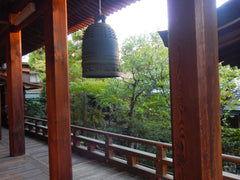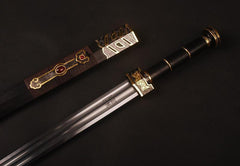A Blade Fit for a King

Li Qiang worked tirelessly to craft the mold. He was an expert Bronze worker and no stranger to sword-making, but this sword was for the king. And not just any king, but King Ghoujin, he who had not only turned the country around through political reforms devised by his astute advisers, but he who had also suffered 3 years as a slave to King Fuchai of Wu and would soon be going back, as leader of the glorious Yue army, to have his revenge.
So Qiang worked for several days straight. He constantly created new molds - experimenting with different lengths and thicknesses, as well as where to put holes for outgassing so the rising bubbles from the hot copper wouldn’t harm the resulting blade. He tried different mixtures of copper and tin - while copper alone is flexible and soft, the addition of tin makes it harder but more prone to shattering. He even added a minute amount of sulfur, so when it came time to inscribe the blade, the inscriptions wouldn’t tarnish with time.
Finally, one day, he had it: a straight, double-sided blade. Coloured like gold, true and hard, a gift fit for a king. A true Jian. All it needed now was the inscription. Tomorrow, Qiang would take it to a colleague who would inscribe the words “King Ghoujin’s personal sword”.
Featured Sword: Jian
Chinese swords are divided into two types: the Jian and the Dao. They were both considered one of the Five Weapons - along with the spear, halberd, and staff.

Swords of the Jian type are double-edged and straight. Originally descended from daggers, they were the first type of sword in China. Because of the poor swordsmithing techniques available at the time, they were not considered very reliable as they tended to break easily - not desired behaviour in a weapon one’s life depends upon. They were also hard to use, requiring much training to become proficient. Thus, when the Dao came along, they were quickly supplanted. Needless to say, with modern swordsmithing, Jian swords are much more reliable, though they still require training to use effectively.
The Sword of Ghoujin

The bronze sword made by Li Qang is known as the famous “Sword Of Ghoujin”, one of the earliest examples of a bronze sword from ancient China. What makes the blade so wondrous is that, 2500 years after its inception, it is still in pristine condition with almost no tarnish. This is made even more incredible by the fact that it was found in a damp tomb. The only damage to the sword was caused after it was found and being displayed abroad, sadly, by a worker who managed to bang the blade against a hard surface while unsheathing it, which caused a small crack on the blade. In response to this, the Chinese government has banned it from leaving the country, and it can be seen only in the Hubei Provincial Museum in Wuhan.
Fun Facts
Jian swords often have tassels. While today they are mainly used decoratively or to change the balance of a sword, there is speculation that in the past they could have been used from such mundane uses as making it easier to hold onto the sword, to offensive uses including blinding or injuring opponents (using metal inserted into the tassel).
Etymology
Jian (traditional: 劍, simplified: 剑, 4th tone) is a Chinese word that originally described Jian-type swords, though in modern usage it has expanded to also mean “double-edged sword” or even swords in general.
Further Reading
If you liked this post and would like to learn about the Jian's sister sword, please check out post Chinese Swords - The Dao.
If you are interested in learning more about the history of both sword types, as well as Chinese swordsmithing in general, please check out our post Chinese Swordsmithing - A Rediscovered Treasure.
source https://www.bladespro.co.uk/blogs/news/chinese-swords-jian

No comments:
Post a Comment